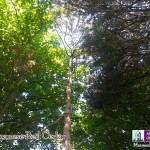
Japanese Red Cedar (Cryptomeria japonica). Several specimens of this tree with a broad columnar habit and reddish peeling bark have been planted in this area of the Quad. The leaves are awl shaped (tapering to a point) arranged around long branchlets. Note the sharp tips of the leaves. The round cones about 2cm in diameter are clothed in short spines. Source: Dr Mary Forrest, UCD.
The Japanese Red Cedar is also known as the Sugi tree. It is an evergreen growing 30 to 50 metres tall, grown in woods, often in pure stands, in rich deep soils; suited to places that are sheltered from strong winds. Its needles shift from a pale opal in the summer to bright red towards the autumn. It is the most important timber tree in Japan, where about one third of the area under cultivation is devoted to it. There the tree is often planted in temple gardens and along roads leading to the temples. Japanese cedar is native to Japan and the coastal provinces of China, but it is often cultivated in Europe and North America. The male Japanese Cedar tree flowers between February and April.
 Japanese Red Cedar, No 5 (6571) - April
Japanese Red Cedar, No 5 (6571) - April
 Japanese Red Cedar, No 5 (6571) - June
Japanese Red Cedar, No 5 (6571) - June
Link: Wikipedia
Link: Google Images
Link: Royal Horticultural Society, UK
Link: Tree Council of Ireland: list of heritage Trees; scroll down list of Common Names to ‘Japanese Red Cedar’ for locations of this tree in Ireland.
Link: Kew Gardens
Link: North Carolina State University: catelogue of trees
Link: Keele University, UK
Link: Plant Database UK: catelogue of trees
Link: Google Streetview